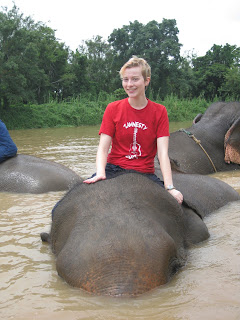Hi there! I'm
Rebecca, one of the new research assistants here at TEI. I'm from central Massachusetts, so this has
certainly been a big change in climate/geography/language from home. After a month in the Golden Triangle, I think
I'm finally settling into life in a Thai village (of course, I don't think I'll
ever get used to elephants!). One of the
things I find most interesting about elephants is the relationship between them
and humans, and the ways that we have affected each other.
Elephants have worked with humans for thousands of years--in
Thailand, elephants are inexorably tied to every aspect of the culture. Elephants were used in war, as a symbol of
royalty, in the logging industry, and, more recently, in tourism. However, are these animals what we would
consider "domesticated?" In
order to answer that question, we need to look at the history and the science
of the domestication process.
Domestication, in the most technical sense, is the process
of artificial selection. This means that
humans, versus evolutionary pressures, artificially choose what traits should
be passed on in an animal population. In
dogs, for example, humans looked for friendliness, loyalty, and, in some breeds,
a specific hunting ability. Corgis were
bred to herd livestock, and thus even corgis that have never worked on a farm
will instinctually try to "herd" other animals (or even
children!). Dogs have thus evolved
alongside humans, and have developed significant abilities in understanding
human behavior. Most interestingly, dogs
can recognize the meaning of a human pointing to an object--they can even
follow a person's gaze to locate a hidden object. Wolves, on the other hand, do not understand
these types of gestures. Even wolves
raised in captivity do not have this ability.
Cardigan Welsh Corgi and Canis lupus photos via Wikimedia Commons
In addition, domesticated dogs are physically different from
their wild predecessors. Many of these
differences were chosen artificially for aesthetic reasons, but some changes in
physical appearance may simply be part of the domestication process. During the 1960s a study was started in the
(then) Soviet Union on the domestication of wild foxes (Trut, 1999). Researchers selected fox pups based solely on
temperament; the most friendly pups were chosen to breed and have pups of their
own. In only a few generations, the
scientists were reliably producing foxes that were friendly and playful with
humans. However, they also discovered
that the foxes were physically different from their wild cousins: the adult domesticated
foxes had floppy ears, curled tails, and some developed piebald coats. None of these traits are expressed in adult
wild foxes; they are, however, found in pups.
Domestication causes neotony, a process through which adults retain
juvenile physical traits. This is why
dogs look more like wolf puppies, rather than adults.
Finally, domestication also changes animal brains. The brains of domesticated animals are smaller
than their wild counterparts, possibly because it results in a reduction of
aggression (McAuliffe, 2011). In
addition, gene expression levels in the brain differ between domesticated and
wild species (Albert et al., 2012). It
seems logical that dramatic behavioral changes would accompany cerebral
changes.
But what about elephants?
Although elephants raised in captivity can be friendly and even
affectionate with the humans they work with, they are not domesticated. They have not changed in appearance due to
generations of human contact, and are behaviorally no different at birth when
born to captive versus wild mothers. If
a calf were born to a captive mother but raised in the wild, that calf would
become a wild adult. On the other hand,
a dog raised in the wild will still retain domesticated characteristics. This is exciting for our research--we are
able to test the intelligence of a group of wild animals in a controlled and
relatively safe setting. And most
importantly, we can use our research and elephants here in the Golden Triangle
to help wild elephants throughout the rest of Asia.
References
Albert FW, Somel M, Carneiro M, Aximu-Petri A, Halbwax M, et
al. (2012) A Comparison of Brain Gene Expression Levels in Domesticated and
Wild Animals. PLoS Genet 8(9): e1002962.
Canis lupus lupus By Quartl (Own work) [CC-BY-SA-3.0 (http://creativecommons.org/licenses/by-sa/3.0)], via Wikimedia Commons
Cardigan Welsh Corgi By Kubek15 (own work on my camera) [Public domain], via Wikimedia Commons
McAuliffe, Kathleen. "If Modern Humans Are So Smart, Why
Are Our Brains Shrinking?" Discover. January 20, 2011.
Trut, Lyudmila (1999). "Early Canid Domestication: The Farm-Fox
Experiment". American
Scientist 87 (2): 160.



No comments:
Post a Comment